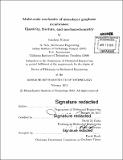| dc.description.abstract | Graphene, owing to its remarkable material properties, is considered as an ideal material for a broad range of nano-scale applications. The performance of any graphene-based device would depend upon the material's response to deformation and its intrinsic resistance to failure. Nano-indentation is a useful technique to obtain such information, but analysis of the nano-indentation of graphene poses unique challenges, due to the multi-scale nature of the underlying processes. A sub-nm scale arises due to the atomic-level activities antecedent to material failure via deformation-induced lattice instability. While elastic instabilities are captured by continuum-level analysis, the soft-mode instabilities are not. Further, the potentially unstable region remains in contact with the nanoindenter and is subjected to high contact stresses which may trigger a strong mechanochemical interaction between graphene and the indenter surface. Such interactions may non-trivially affect the point of elastic to inelastic transition, as well the atomistic mechanism controlling it. A second length-scale, at least two orders of magnitude larger, is set by the scale of the indenter. For these reasons, an accurate analysis of graphene nano-indentation must adequately treat the relevant physical phenomena across these scales, and work carried out in this thesis undertakes this task. First, we propose and calibrate a hyperelastic constitutive modeling scheme for graphene based on symmetry-invariants of the logarithmic strain measure. The model adequately describes both the nonlinear softening and the anisotropy in the material response. For a set of homogeneous finite deformations, the stress values predicted by the model compare well with the directly-calculated ab initio values, validating the fidelity of the model. For a number of biaxial deformation modes the elastic stability limits predicted on the basis of acoustic tensor analysis compare well with results from phonon calculations carried out independently using linear response density functional perturbation theory. Particularly, we show that the limit of elastic stability in equi-biaxial deformation of graphene has been widely misinterpreted as coinciding with achieving peak bi-axial stress. The present continuum formulation, supported by independent phonon calculations, clearly illustrates that an elastic shearing instability precedes the maximum stress configuration under this loading mode. Secondly, we investigate the limits of reversible deformation in graphene under various loadings using atomistic-level lattice-dynamical stability analysis. Based on this information, we construct continuum failure surface for graphene, both in terms of stress, and strain, as a smoothed representation of the envelope of all possible lattice instabilities: long wavelength as well as short wavelength, and structural as well as material failures. The third focus area examines the graphene-diamond interaction as a function of interfacial separation, based on combined density functional theory and molecular dynamic calculations. The calculated interfacial energy as a function of separation exhibits two local minima, indicating that a graphene monolayer on a diamond {111} or {100} surface has two possible equilibrium states: a physisorbed state at low compressive stress, governed by weak vdW forces, and a chemisorbed state at large compressive stress, governed by strong covalent forces. Taking the DFT/ MD energy-separation data as input, we derive a continuum traction-separation relation for graphene- diamond interface, which describes both the weak vdW adhesion and the strong chemical interaction. Finally, we show that existing interpretations of recent nano-indentation experiments on suspended graphene sheets, based on finite element simulations adopting frictionless hard contact models intended to simulate van der Waals interaction, indicate that at experimentally-measured failure loadings, the inferred strain in the graphene sheet directly beneath the diamond indenter is anomalously large compared to the fracture strains predicted by both soft-mode and acoustic lattice stability analyses. We demonstrate that this discrepancy cannot be attributed to deficiencies in the graphene constitutive model, geometric features of the indenter, or the nature of assumed kinematic boundary conditions adopted in the simulations. We examine the implications of inducing strong covalent interactions at the graphene- indenter interface in connection with measured fracture loading levels in nano-indentation experiments. Both finite element and MD simulations suggest that the shear stiction associated with such induced interactions leads to a strain-shielding effect in the graphene. The shear stiction restricts relative slip of the graphene sheet at its contact with the indenter, thus initiating a local strain-shielding effect. As a result, the spatial variation of continuing incremental strain is substantially redistributed, locally limiting the buildup of strain in the region directly beneath the indenter while adding to deformation of nearby, lower-strained regions. The shear strength of the graphene-indenter covalent interaction depends strongly on the level of hydrogen passivation on the indenter tip. Simulations show that at intermediate levels of hydrogen saturation, the strain-shielding effect redistributes strain in the graphene so that experimentally-determined fracture loading can be supported without prematurely reaching locally-limiting states of lattice deformation and stress. | en_US |
